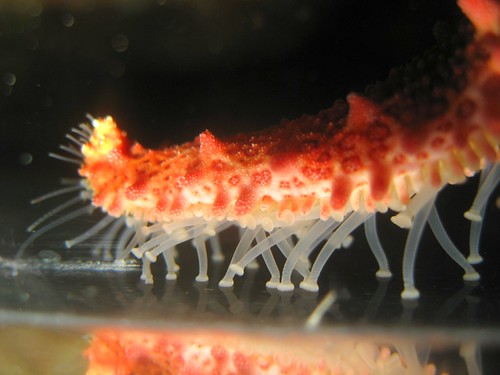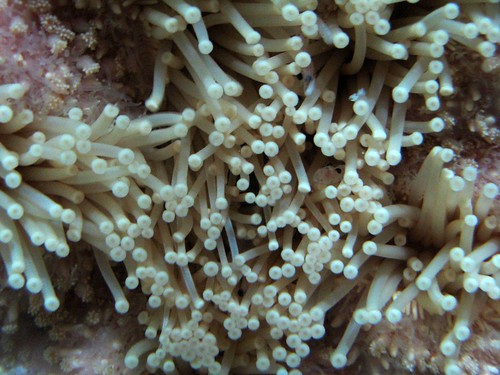Image by veronica07
I betcha you guys didn't know that starfish left FOOTPRINTS did ya?? I don't just mean impressions on the sand..I mean, put a starfish on a smooth surface, like glass or rock and it leaves you one of these...
WHAT?? How does THAT work?
Hasn't the model always been that starfish tube feet work like suction cups (such as here) ???? Why would they leave footprints on a smooth surface if they work like suction cups??

Image by Symbiotics
THAT is a good question.
To answer it, I consulted the works of Patrick Flammang and his research lab at the University of Mons in Belgium. One of many papers addressing the biology of tube feet is utilized here (written by Elise Hennebert and others in Flammang's lab)
It turns out that the whole chemistry and physical processes of tube foot adhesion is actually quite complex and has very useful applications in adhesives, glues and so forth.
There is an important lesson to be learned here. This field of study started largely as an academic pursuit, to learn about the mechanisms used by these animals to survive in their habitat but may soon lead to something with many practical applications..
See this article awhile back about how Gecko adhesion has led to new types of adhesives! Adhesives that work under water would presumably have a multitude of uses..
There is an important lesson to be learned here. This field of study started largely as an academic pursuit, to learn about the mechanisms used by these animals to survive in their habitat but may soon lead to something with many practical applications..
See this article awhile back about how Gecko adhesion has led to new types of adhesives! Adhesives that work under water would presumably have a multitude of uses..
How does this whole tube foot adhesion/stick to the ground thing work?? Here's a breakdown of the process as taken from Hennebert et al. (2008) in the Journal of Structural Biology...
1.Contact! The process begins with the contact of the tube foot with the ground/substratum.
There is a special layer called the "fuzzy coat" (shown below in red) which is present on the surface of the disk epidermis making contact with the bottom.
There is a special layer called the "fuzzy coat" (shown below in red) which is present on the surface of the disk epidermis making contact with the bottom.
 |
| Echinoblog Art Dept.- Note that "Smuck" is not known to be a true starfish tube foot noise! |
 |
| Echinoblog Art Dept. Did you know that ! can be used to make everything more exciting?!! |
 |
| Echinoblog Art Dept. Coloring is fun! |
 |
| fig. 1B from Hennebert et al. 2008 |
This leaves the "fluffy layer" and the "bulked" material behind...
Here is an SEM of what this looks like after the tube feet have been pulled away
 |
| Figure 2C from Hennebert et al. |
5. Footprint And the wet parts of the "fluffy layer" dry out leaving the "bulked" material aka the starfish (or whatever) footprint..
Here is what that part which is left behind looks like in 3D via Transmission and Atomic Force Microscopy
 |
| Fig. 3 from Hennebert et al. |
And here is an image of the tube foot "foot print" as seen directly off a piece of glass..
And so...
What about that classic paradigm about suckers on sea stars and other echinoderm tube feet basically being suction cups???
Well, nothing definitive has been published as yet..but Flammang's lab has published on these adhesive processes in tube feet for over 10 years. A title from an oral presentation at one of the last European echinoderm conferences by Elise Hennebert, Romana Santos and Patrick Flammang here, entitled "Echinoderms don't suck" does seem to imply the days of that mechanism are numbered.
Bear in mind that this doesn't even necessarily end with this one tube foot type. There are at least two other forms of tube feet and exploring the various mechanisms at play could be fruitful indeed...
In addition to the lab run by Patrick Flammang at the University of Mons, this lab in the UK (shown in this video) has also undertaken research into this area to understand the nature of tube foot adhesives...
UPDATE: To see the follow up to this story and to see how "echinoderms don't suck" go here!
Bear in mind that this doesn't even necessarily end with this one tube foot type. There are at least two other forms of tube feet and exploring the various mechanisms at play could be fruitful indeed...
In addition to the lab run by Patrick Flammang at the University of Mons, this lab in the UK (shown in this video) has also undertaken research into this area to understand the nature of tube foot adhesives...
UPDATE: To see the follow up to this story and to see how "echinoderms don't suck" go here!




7 comments:
That's cool stuff, Chris. I always thought there was more to it than simple suction cups.
Hi Chris,
It is older than that...
The explanation dates back to Colin Herman's lab in the 1980s. If I remember properly it got started when a student noticed Luidia folioltata climbing up and sticking to the sides of an aquarium just subsequently to hearing the old tale of suction cupped tube feet in sea stars. Of course, this was very interesting as L. foliolata lacks suckers on its tube feet.
See here: The duo-gland adhesive system, Hermans, CO (1983). The duo-gland adhesive system
Oceanogr. Mar. Biol. Ann. Rev. 21 : 283-339
Here is another good starter reference: Thomas, L. A. and C. Hermans. 1988. Adhesive interactions between the tube feet of a starfish, Leptasteria hexactis and substrata. Biol. Bull. 169. 675-688.
http://www.biolbull.org/content/169/3/675.full.pdf
thanks Ron!
Hi Chris - I found this post via Al Dove's blog. Really fascinating stuff! Just another example of how we take the complexity of nature for granted and should be looking there for solutions to many of our problems.
thanks! I think it also hits home how "basic" research can ultimately benefit a broader field even if it doesn't seem to be "practical" at first...
You are absolutely right. We often don't spend enough time figuring out how stuff works when that bit is really crucial. I am definitely guilty of thinking the time of just learning for the sake of learning is over as our environment has so many problems and we should really be focusing on fixing them and not hiding in a lab. BUT, your research is a great example of how people could be inspired to care about nature just a little bit more because nature can help us solve problems. Every time a species disappears, or an ecosystem is tainted, we are potentially losing resources. This is a completely different reason to support conservation and one we are not relying on enough!
Good for you, Ron! I had same thought - Colin H pretty much showed this, and published the definitive review of duo gland systems. You and I were still reading 100-yr old lit in 70s and 80s; now no one reads anything more than 10 yr old - certainly not from last century! Even with advantage of Google. Sad. It isn't real until it's been tweeted.
Jon Norenburg
Post a Comment